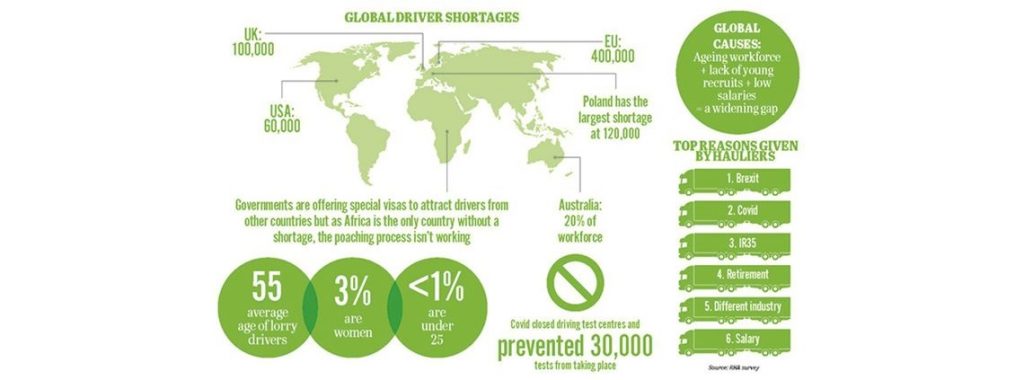What will it take to resolve the HGV driver shortage?

Blame for the global crisis has been pinned on numerous factors, but with the situation set to worsen we uncover the root causes of the driver deficit and why pay rises aren’t enough to fix the problem
First it was groceries. Supermarkets warned that supplies of fresh foods were being threatened and certain product lines may be missing from stores, but ears really pricked up when beer deliveries stalled and supplies started running low.
Now, it’s shaping up to be a not-so-merry Christmas as hauliers warn the ongoing shortage of HGV drivers will not only reduce the amount of turkeys, toys and wine on the shelves, but the lower availability will push up prices as shoppers battle to stock up for the holidays. Will we still see the beloved festive commercials showing a jolly Santa Claus driving a long-haul truck of Coca-Cola to kick off the holiday season?
Unfortunately, the issue will not come to a neat end in December. The HGV driver shortage has affected multiple countries and global supply chains, with Transport Intelligence estimating Europe is lacking around 400,000 drivers. The UK has reported a shortfall of around 100,000, similar to the US as the existing shortfall of 60,000 from 2019 is expected to rise to 100,000 by 2023.
HGV drivers are an integral part of global supply chains and the crisis has seen wages and bonuses rocket in an attempt to retain and attract workers – but this isn’t working. US haulage company CR England announced in April it had undergone its third pay hike in three years. The company said driver pay is now 50% higher than in 2018. Rather than attract new people, the power shift means workers can be more selective and “bounce” between jobs.
It appears the situation is likely to worsen, raising pressure on supplies and increasing prices as stores pass costs on to customers. So if wages aren’t the answer, what is driving the global shortage?
Origins of the issue
Transport Intelligence estimated that HGV driver shortages have been building for the past 15 years, stretching back far beyond Brexit and the Covid-19 pandemic – though these events have exacerbated the situation and revealed weaknesses in global supply chains. Research shows the leading contributing factors to the shortage are an ageing workforce and a lack of young people entering the profession.
The Road Haulage Association found that 58% of haulage companies in the UK cited drivers retiring as a key factor. With the average age of lorry drivers at around 55 years, it is estimated that a third of the workforce is expected to leave the industry within the next five years alone.
This has been compounded by efforts that don’t go far enough to attract young people to the industry, let alone to retain them. The RHA found that only 25% of SME logistics firms employ apprentices. In fact, the Labour Party in the UK claimed the number of young people taking up transportation apprenticeships has fallen by almost half (49%) since 2015-2016.
This is being echoed across the pond, where US firms have reached the same conclusion, and in the EU, where only around 7% of European drivers are below the age of 25.
It’s fair to say that though not the main cause, politics has had a wide-ranging effect on driver shortages. Critics argue that changes to mobility package rules in Europe, due to come into play in 2022, will make it harder to cabotage drivers from neighbouring countries. Additionally, Covid and Brexit have played their part.
Alex Veitch, general manager of public policy at Logistics UK, said “there was a shortage of HGV drivers prior to Covid-19 and Brexit, but these two events have exacerbated the situation”. Indeed, the RHA found that although 25,000 EU drivers returned to their home countries following Brexit, this bumped up the worker gap by a quarter, hitting 100,000.
Daily news stories of the latest shortages make the situation clear. While Poland has the biggest driver deficit in Europe at 120,000, it is the UK that has felt the impact most acutely with high visibility of goods missing from retailers, restaurants and hospitality firms taking products off menus, and panic buying in response to rumours of a pinch on petrol.
Michael Clover, head of commercial development at Transport Intelligence, said the UK is vulnerable to “structural problems” in its road freight due to a “trade imbalance”. Up to 60% of EU trucks delivering supplies to the UK do not carry exports and return empty, diverting logistics firms away from the UK.
“When there are around 300,000 drivers short across continental Europe, there is little incentive to send freight to the UK,” he said.
Potential for resolution?
For many companies, the response was to dramatically raise wages and offer large bonuses to attract workers, but even this has resulted in competition to keep staff and threats of strikes if no pay rise is offered. Haulage firms and private retailers alike have raised the stakes, and recruitment firm Adzuna confirmed LGV wages had increased by 21% in just under a year. But higher salaries alone will not solve the shortages, Clover argued.
“Driving trucks has an image problem,” Clover said. “It’s been a job that lots of people have not wanted to go into. Younger generations have turned away from doing it because people have been seeking a better work-life balance. The idea of being a truck driver and constantly on the road, living in quite bad conditions, often sleeping in your truck, has not really been very appealing.”
The World Transport Organisation (known as the IRU) figures show there are around 100,000 fewer truck parking spaces available in the EU than required. Only 7,000 of the ones available – less than 3% – are in certified “safe and secure” areas.
A lack of secure facilities is causing systemic issues in recruitment, Clover argued: “One of the big concerns for female drivers or prospective female drivers is the safety issue at truck stops.” Consequently, only an estimated 2-3% of all HGV drivers are women, according to the IRU. But while this is currently a barrier deterring a demographic from the industry, addressing it provides a “huge pool of opportunity”.
The EU has looked to tackle this with extra funding to increase the number of secure parking areas across Europe. It is estimated that a total of €178m will be awarded to logistics companies that decide to create safe parking areas for trucks based on a uniform European set of standards.
Opportunity for change
Charlie Walker, head of sales at Walker Logistics, said: “The uncomfortable truth is that lorry drivers have been undervalued and treated disrespectfully for years – not only by society in general but by sections of the industry in which they operate.” Drivers are “absolutely vital” to our supply chains, he added.
Clover argued that while the haulage sector has faced increasing pressures following Covid-19, this also presents an opportunity for much-needed reform.
“I think that’s a nice silver lining,” he said, referring to rising wages and more discussions about driver welfare, “and something that should have changed a long time ago. Logistics, supply chain, and road freight is all important for all our daily lives, and probably hasn’t had the recognition for that. The pandemic has highlighted that drivers are key workers.”

